Xi'an, part 2
I said I was going to write part 2 of the Xi'an trip, but the trip itself set me behind in grading, and I've been trying to get several things settled, including figuring out how to pay our tour guide (more on that later), and get everyone's visas to go to Vietnam.And all of a sudden my internet connection goes out. I can ping the router, but not the DNS server or anything else in the area. So I'm typing this off-line and I'll upload it when the internet comes back on. The internet connection at HKBU is pretty slow, and temperamental. You'd think that in Hong Kong, where top-of-the-line technology is available for low prices, that HKBU would be much better than anywhere else I've seen, but instead it's much worse than everything else except dialup.
Anyway, the highlight of the trip to Xi'an was, for me, the trip to the Da Qin Christian monastery. See two posts ago for a historical view of this, and see the last post for some stuff about the stone tablet discovered in the 16th century.
The monastery was discovered many times, most recently by a team by Martin Palmer with local contact Peter Zhao (Zhao Xiaomin). In 1998 they stumbled upon this site near a famous Taoist site, and Martin, who knows Christian iconography, recognized that not only was this pagoda not a typical Chinese pagoda, but everything about it was Christian. A local nun said, "Sure, it's a Christian pagoda. We all know that."
I tried to find how to get into this site, and eventually ended up emailing Martin Palmer, who put me in touch with Peter Zhao. He arranged everything in this Xi'an trip and gave us an introduction to the Christian pagoda.
It's about an hour to the southwest of Xi'an, at the base of the Qingling mountains dividing North China from South China, in the middle of farm country. Corn fields, everywhere. People picking corn, drying corn, laying corn on the sides of roads, grinding corn. Made the folks from Ohio University feel right at home.
There are a bunch of locals trying to get us to ride horses. A few of us took them up on the offer. It's not too far to walk, and the horses don't get you there any faster, but for some, it was an opportunity not to be missed. Here's Blair Warner on one.

The pagoda stands, or rather tilts, in the middle of these corn fields. It has leaned since an earthquake in the 1500s.
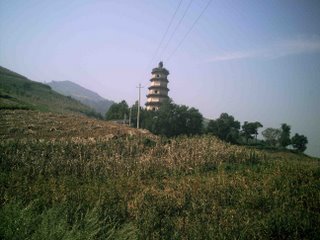
This is where there is a replica of the stone monument and where I bought the rubbings. By the way, I found out that typing in Chinese is already built into my computer. Yay, Apple! I just go to System Preferences, International, and Input Menu, and select that i want to be able to enter stuff in Chinese. 中文。That means "Chinese". It's hard to type this, because I don't have the characters marked on my keyboard, which means I'm doing this by trial and error, mostly.
So anyway, one of these days I'm going to type in the text of the rubbing and then the internet will truly have everything.
The bottom is now a Buddhist shrine, but the statues in there kind of creeped me out. I think because they're designed to appear like they're always staring at you.
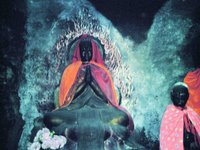
To enter the rest of the pagoda, they built a ladder out of pipes. I kid you not--there's no regular entrance; every time someone wants to come, they build the ladder again. The rungs were far apart and not consistently spaced, and it went up the side of a tilting building. Still, many of us went up.
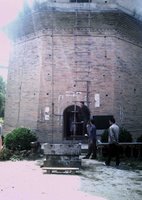
Here's a nativity scene on the second floor, or at least the direction of the legs fits the pattern of Eastern Orthodox nativity scenes.

I'd read that the stairs in 1998 were missing several pieces and the remaining pieces were in bad shape. Now they're fine, except that they are a bit irregular and sometimes slope in unpredictable ways. That and sometimes it's hard to maneuver to them. Yet there's electric lighting up here, apparently.

At the top, we rest for pictures of the scenery around us. Way down there are the horses. We truly are in the middle of nowhere.
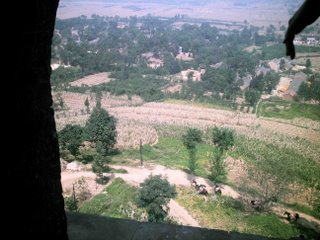
The hand there is Andrea's. She insisted on walking on the outside of the pagoda, on the rim. In fact, dancing. Did I tell you this pagoda leans? And it's 1300 years old?! Someone else joined her. Was it Nicole? Or Delia? I forgot. But they're the ones who also joined me in jumping off of Macau Tower. I think walking around like that was the highlight for them. For others, it was the fact that we're looking at an ancient site and we're the only tourists in sight. For me, it was the fact that this was built by people who share my faith in Jesus but who have a completely different cultural mindset, more Eastern than Western.
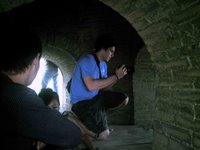
There's a sublime mixture of darkness and light here, like twilight. Very dark in the pagoda, but light coming from the outside. Here's Yee, from Ohio University, right at the border.

Then there's going back down that ladder. Yikes.
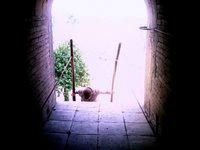
Next we went to the nearby site of Lou Tai Guan, where legend has it that Lao Zi, the founder of Taoism, wrote the "scripture" of Taoism, the Tao Te Ching, in one night, as he was about to leave China forever to wander the mountains of the west. In the Tang dynasty, the emperors viewed themselves as descendants of Lao Zi, and emphasized Taoist sites like this one.
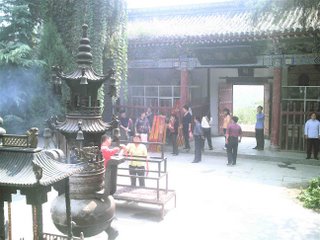
The Tao Te Ching is inscribed in tablets behind the two red-fenced areas near the entrance in the picture.
The fact that the Tang emperor invited the Nestorian church to build a pagoda in the midst of this the most sacred of Taoist complexes, so near the capital, is nothing short of astounding, especially since the emperor viewed himself as in some way a successor of Lao Zi. Perhaps there is truth in the statements of the monument that the emperor came to see truth in the Christian monks' teachings, and accepted Christianity as part of Taoism.
Still, at the side of the Taoist temple, there are a pair of bronze lions, which Peter Zhao says was built shortly after the Christians put up their pagoda. They are guards, and directly face the Christian pagoda. The Taoist priests may not have been able to countermand the Emperor's orders to allow the Christian pagoda, but they could set up things like this to register their protest.
The bus driver, meanwhile, bought a puppy for 100 RMB (about $12 USD) from a local farmer. He was very cute and was brown with black tiger-like stripes.
We then saw a modern Christian church in a nearby village. It was destroyed in the Cultural Revolution of the 1960s but rebulit soon thereafter.
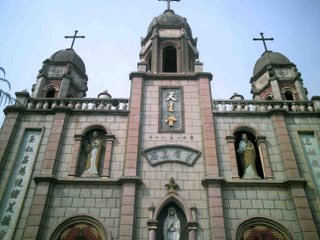
They say the Nestorian church died out long ago, but why is Christianity so strong in this countryside area? Perhaps when waves of persecution hit, they went underground every time, and according to the official documents, Christianity died out. But in reality, who can track what goes on in the remote countryside?
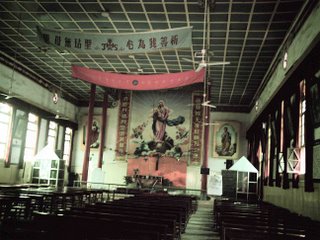
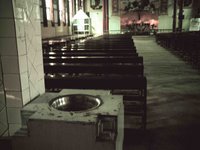
All in all, a very worthwhile trip. It was a hassle to get here, but I'm glad we came. I learned a lot along the way. And got to meet Peter Zhao. Apparently very few people come to this site--mostly the few scholars who really know about Nestorian Christianity in 7th century China. He estimates around 500 people came to visit last year. More than I thought, but still really very few.
I'm really indebted to Peter. Now, fairly literally. I brought HK$10,000 to help pay for things when I arrived but I didn't have the full amount. The reason for that is my bank has a limit for how much I can withdraw in one day. The students are paying me back now, but in US dollars in checks, which I will mail to my bank. Peter said we should go to the bank to do a cash transfer. I hand them my credit card, and they deposit the money into Peter's account. This did not work. One bank said we had to go to the main branch to do transfers. We went to the main bank and they couldn't get my card to work. I tried several cards, and smaller amounts. To no avail. They concluded they just can't handle international credit cards. We needed to get a card from China Construction Bank or China Agricultural Bank or something like that. You know, the regular ones you can get if you are Chinese.

This China Construction Bank in Xi'an is under construction. The bottom left stuff is bamboo scaffolding holding up tarps.
I instead withdrew the maximum from an ATM and handed it to Peter. I now have to pay the remaining balance, and it's been difficult. Peter says I can just go to a Hong Kong bank and try the same thing. Each one says I need an account there. I might get an account just to get this thing going, even though it takes a lot of random paperwork and evidence to get an account. But there's also the issue of how to get money to my new Hong Kong account from my US account. Apparently I need to tell my US bank to do it. Which then raises the question: Why not just ask my US bank to pay Peter directly?
Well, I called Washington Mutual, long distance, and they said I had to be present at the bank to do a cash transfer.
In the meantime I'm just withdrawing the maximum from my ATM so that if worse came to worse, I can just deposit the money into Peter's account.
Well, now the internet is working so I can finally upload this all. I'm still in my office at 12:34 am, because I don't want to do this at home--the internet connection there is usually so slow, it times out when I try to upload pictures onto the blog.
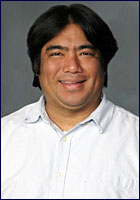

2 Comments:
Wow...it sounds like you all had an awesome trip. Part of me wishes I would've gone now (especially to walk around the outside of the Pagoda!). I will try to get into touch with the mountaineering club, albeit probably not until we return from Vietnam. Thanks for the tip. Hope you had a good weekend and I'll see you tomorrow night.
Thanks for the post. I'll see you tomorrow.
Post a Comment
<< Home